实验1
实验1
#include<iostream> #include<string> #include<vector> int main() { using namespace std; string s1; string s2{"c plus plus"}; string s3{s2}; string s4=s2; s1="oop"; vector<string> v1; v1.push_back(s1); v1.push_back(s2+"1"); v1.push_back(s3+"2"); v1.push_back(s4+"3"); cout<<"output1:"<<endl; for(auto item:v1) cout<<item<<endl; cout<<"output2:"<<endl; for(auto p=v1.begin();p!=v1.end();++p) cout<<*p<<endl; cout<<"output3:"<<endl; for(auto i=0;i<v1.size();++i) cout<<v1[i]<<endl; vector<string>v2{v1.rbegin(),v1.rend()}; cout<<"v2:"<<endl; for(auto item:v2) cout<<item<<endl; }
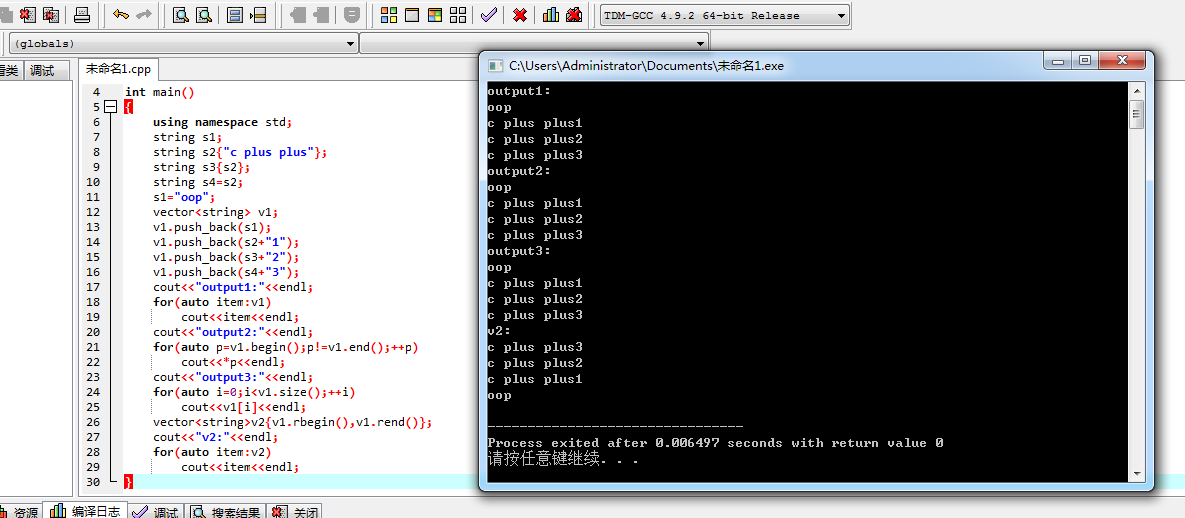
#include<iostream> #include<string> #include<vector> #include<cmath> #include<cstdlib> #include<time.h> template<typename T> void output(const T& obj) { for (auto item : obj) std::cout << item << " "; std::cout << std::endl; } int main() { using namespace std; vector<int>v1{ 1,9,8,4 }; v1.insert(v1.begin(), 2022); v1.insert(v1.end(), 2023); cout << "v1: "; output(v1); v1.pop_back(); v1.erase(v1.begin()); cout << "v1: "; output(v1); vector<string>v2{ "《1984》","《动物农场》","《美丽新世界》" }; cout << "v2: "; output(v2); }
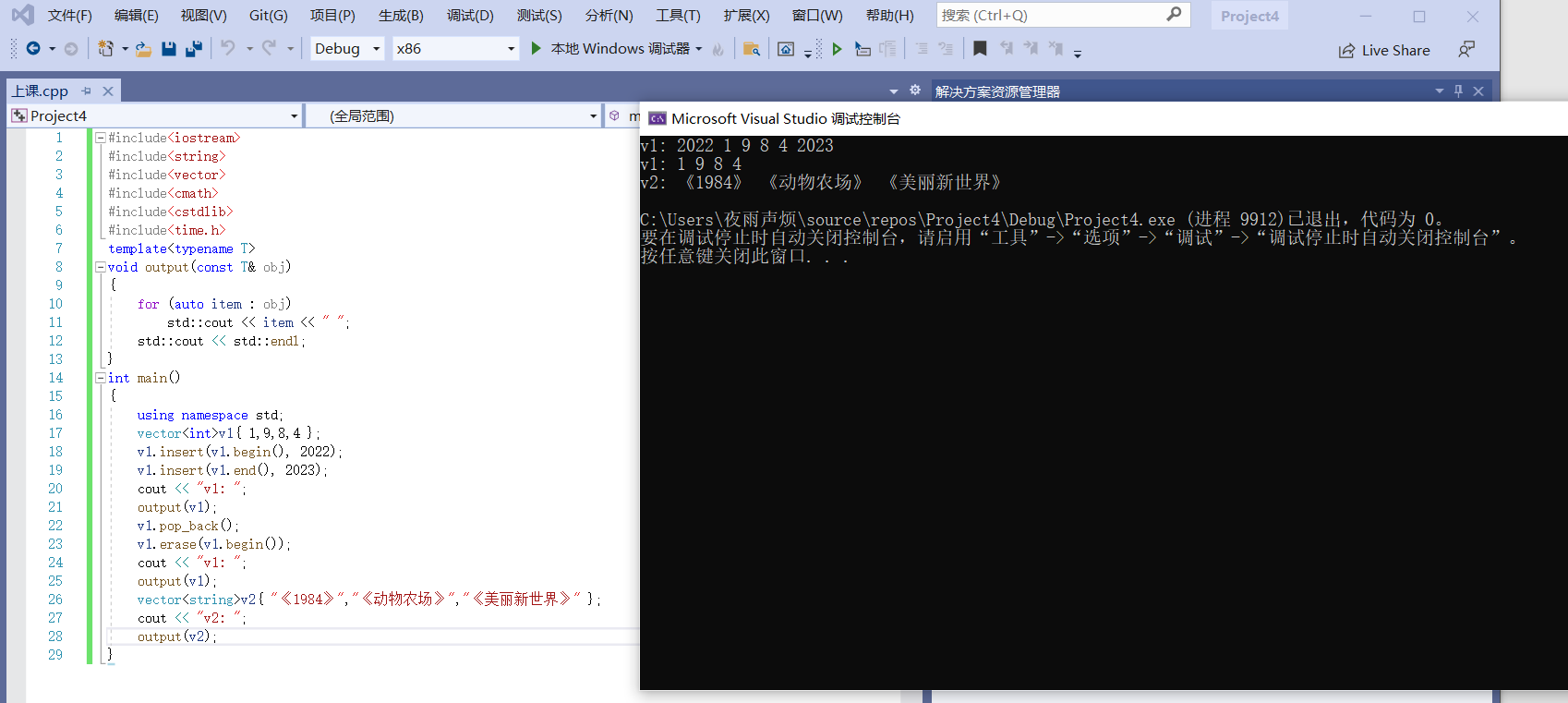
实验2
#include<iostream> using std::cout; using std::endl; class Point { public: Point(int x0 = 0, int y0 = 0); Point(const Point& P); ~Point() = default; int get_x()const { return x; } int get_y()const { return y; } void show()const; private: int x, y; }; Point::Point(int x0, int y0) :x{ x0 }, y{ y0 }{ cout << "constructor called." << endl; } Point::Point(const Point& p) : x{ p.x }, y{ p.y }{ cout << "copy constructor called." << endl; } void Point::show()const { cout << "(" << x << "," << y << ")" << endl; } int main() { Point p1(9, 2); p1.show(); Point p2 = p1; p2.show(); Point p3{ p2 }; p3.show(); cout << p3.get_x() << endl; }
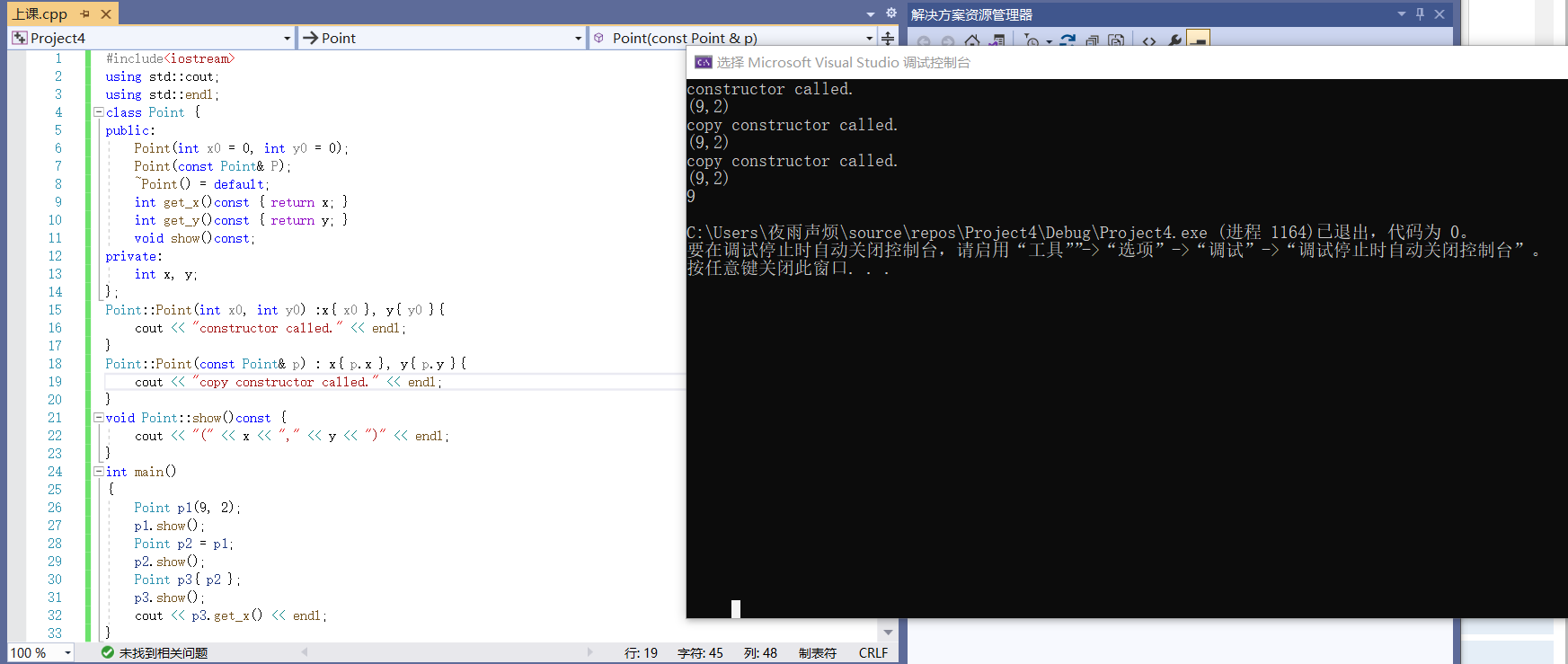
实验3
#include<iostream> #include<iomanip> using std::cout; using std::endl; class Clock { public: Clock(int h = 0, int m = 0, int s = 0); Clock(const Clock& t); ~Clock() = default; void set_time(int h, int m = 0, int s = 0); void show_time()const; private: int hour, minute, second; }; Clock::Clock(int h, int m, int s) :hour{ h }, minute{ m }, second{ s }{ cout << "constructor called" << endl; } Clock::Clock(const Clock& t) : hour{ t.hour }, minute{ t.minute }, second{ t.second }{ cout << "copy constructor called" << endl; } void Clock::set_time(int h, int m, int s) { hour = h; minute = m; second = s; } void Clock::show_time()const { using std::setw; using std::setfill; cout << setfill('0') << setw(2) << hour << ":" << setw(2) << minute << ":" << setw(2) << second << endl; } Clock reset() { return Clock(0, 0, 0); } int main() { Clock c1(11, 50, 0); c1.show_time(); c1 = reset(); c1.show_time(); Clock c2(c1); c2.set_time(6); c2.show_time(); }

实验4
#include<iostream> class X { public: X(); ~X(); X(int m); X(const X& obj); X(X&& obj) noexcept; void show()const; private: int data; }; X::X() :data{ 42 } { std::cout << "default constructor called.\n"; } X::~X() { std::cout << "destructor called.\n"; } X::X(int m) :data{ m } { std::cout << "constructor called.\n"; } X::X(const X& obj) :data{ obj.data } { std::cout << "copy constructor called.\n"; } X::X(X&& obj)noexcept :data{ obj.data } { std::cout << "move constructor called.\n"; } void X::show()const { std::cout << data << std::endl; } int main() { X x1; x1.show(); X x2{ 2049 }; x2.show(); X x3{ x1 }; x3.show(); X x4{ std::move(x2) }; x4.show(); }
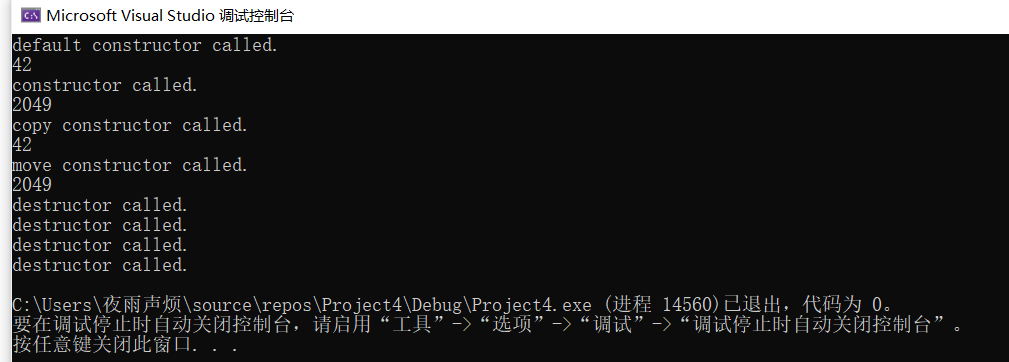
分析:
创建X x1时,默认构造函数被调用,函数执行完成后对x1所占的资源进行了清理;
创建X x2{2049}时,构造函数被调用,函数执行完成后对x2进行了清理;
创建X x3{x1}时,复制构造函数被调用,函数执行完成后对x3所占资源进行了清理;
创建X x4{std::move(x2)}时,移动构造函数被调用,执行完成后对x4进行了清理;
实验5
#include<iostream> #include<iomanip> class Rectangle { public: Rectangle(float l = 2.0, float w = 1.0) :length{ l }, width{ w }{} Rectangle(const Rectangle& obj) : length{ obj.length }, width{ obj.width }{} ~Rectangle() = default; float len() const { return length; } float wide()const { return width; } float area()const { return length * width; } float circumference()const { return 2 * (length + width); } void resize(int time); void resize(int l_times, int w_times); private: float length, width; }; void Rectangle::resize(int n) { length *= n; width *= n; } void Rectangle::resize(int l_times, int w_times) { length *= l_times; width *= w_times; } void output(const Rectangle &rect) { using namespace std; cout << "矩形信息:\n"; cout << fixed << setprecision(2); cout << std::left << setw(8)<<"长:" << rect.len() << endl; cout << std::left << setw(8) << "宽:" << rect.wide() << endl; cout << std::left << setw(8) << "面积:" << rect.area() << endl; cout << std::left << setw(8) << "周长:" << rect.circumference() << endl; cout << endl; } int main() { Rectangle rect1; output(rect1); Rectangle rect2(10, 5); output(rect2); Rectangle rect3(rect1); rect3.resize(2); output(rect3); rect3.resize(5, 2); output(rect3); }
原数据结果

修改数据后
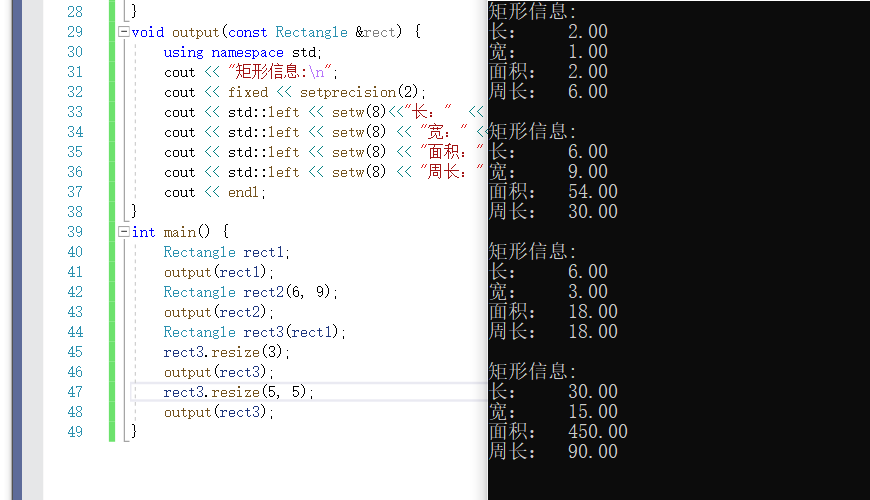



 浙公网安备 33010602011771号
浙公网安备 33010602011771号